How the COVID-19 infection tsunami revolutionized the work of respiratory physiotherapists: an experience from Northern Italy

Published: May 19, 2020
Abstract Views: 9363
PDF: 5513
Publisher's note
All claims expressed in this article are solely those of the authors and do not necessarily represent those of their affiliated organizations, or those of the publisher, the editors and the reviewers. Any product that may be evaluated in this article or claim that may be made by its manufacturer is not guaranteed or endorsed by the publisher.
All claims expressed in this article are solely those of the authors and do not necessarily represent those of their affiliated organizations, or those of the publisher, the editors and the reviewers. Any product that may be evaluated in this article or claim that may be made by its manufacturer is not guaranteed or endorsed by the publisher.
Similar Articles
- Massimiliano Polastri, Lara Pisani, Andrea Dell'Amore, Stefano Nava, Revolving door respiratory patients: A rehabilitative perspective , Monaldi Archives for Chest Disease: Vol. 87 No. 3 (2017)
- Gianfranco Beghi, Antonio De Tanti, Paolo Serafini, Chiara Bertolino, Antonietta Celentano, Graziella Taormina, Monitoring of hospital acquired pneumonia in patients with severe brain injury on first access to intensive neurological rehabilitation: First year of observation , Monaldi Archives for Chest Disease: Vol. 88 No. 1 (2018)
- Muhammad Ijaz, Muhammad Jaffar Khan, Jawad Khan, . Usama, Association of clinical characteristics of patients presenting with influenza like illness or severe acute respiratory illness with development of acute respiratory distress syndrome , Monaldi Archives for Chest Disease: Vol. 87 No. 1 (2017)
- Marinella Sommaruga, Elisabetta Angelino, Paola Della Porta, Mara Abatello, Giacomo Baiardo, Gianluigi Balestroni, Ornella Bettinardi, Edward Callus, Chiara Ciracì, Ombretta Omodeo, Claudia Rizza, Paolo Michielin, Marco Ambrosetti, Raffaele Griffo, Roberto F.E. Pedretti, Antonia Pierobon, Best practice in psychological activities in cardiovascular prevention and rehabilitation: Position Paper , Monaldi Archives for Chest Disease: Vol. 88 No. 2 (2018)
- The Rehabilitation Complexity Scale for respiratory patients - Italian network, The ability of the Rehabilitation Complexity Scale to capture the burden of care and disability in patients with respiratory diseases admitted for in-hospital rehabilitation: a pilot study , Monaldi Archives for Chest Disease: Vol. 94 No. 4 (2024)
- Susanna Ricotti, Valentina Martinelli, Patrick Caspani, Serena Monteleone, Lucia Petrucci, Elena Dalla Toffola, Catherine Klersy, Changes in quality of life and functional capacity after lung transplantation: A single-center experience , Monaldi Archives for Chest Disease: Vol. 87 No. 3 (2017)
- Mara Paneroni, Francesco D' Abrosca, Georges Fokom, Laura Comini, Michele Vitacca, Volitional rehabilitative assessments in patients admitted in a post-intensive care step down unit. A feasibility study , Monaldi Archives for Chest Disease: Vol. 87 No. 1 (2017)
- Claudio F. Donner, Sandro Amaducci, Elena Bacci, Sandra Baldacci, Maria L. Bartoli, Gianfranco M. Beghi, Alida Benfante, Sara Brighindi, Lucio Casali, Daniela Castiglia, Mario Cazzola, Alessandro Celi, Silvana Cianchetti, Giorgio Colombo, Claudia Crimi, Federico L. Dente, Giuseppe Di Maria, Annalisa Di Maria, Manuela Latorre, Federico Lavorini, Sara Maio, Claudia Mannini, Riccardo Messina, Pier Luigi Paggiaro, Patrizia Pignatti, David Price, Nicola Scichilone, Marzia Simoni, Antonio Spanevello, Martina Stagno d’Alcontres, Shawna Tan, Roberto Torchio, Giovanni Viegi, Dina Visca, Emiel F.M. Wouters, Shaylynn Yu Hui Xin, Inhalation therapy in the next decade: Determinants of adherence to treatment in asthma and COPD , Monaldi Archives for Chest Disease: Vol. 88 No. 1 (2018)
- Michele Vitacca, Piero Ceriana, Bruno Balbi , Claudio Bruschi, Maria Aliani, Mauro Maniscalco, Francesco Fanfulla, Aldo Diasparra, Luigino Rizzello, Daniela Sereni, Antonio Spanevello, The respiratory rehabilitation Maugeri network service reconfiguration after 1 year of COVID-19 , Monaldi Archives for Chest Disease: Vol. 91 No. 4 (2021)
- Michele Vitacca, Luca Barbano, Daniele Colombo, Olivia Leoni, Enrico Guffanti, Prevalence and variability of use of home mechanical ventilators, positive airway pressure and oxygen devices in the Lombardy region, Italy , Monaldi Archives for Chest Disease: Vol. 88 No. 1 (2018)
You may also start an advanced similarity search for this article.

 https://doi.org/10.4081/monaldi.2020.1085
https://doi.org/10.4081/monaldi.2020.1085




